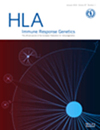TISSUE ANTIGENS 期刊简介

HLA publishes full-length original articles, brief communications, commentaries and occasional reviews on research in: immunogenetics of cell surface antigens; ontogeny and phylogeny of the immune system; immunogenetics of cell interactions; functional aspects of cell surface molecules and their natural ligands, such as cytokines, adhesion molecules and activation antigens; role of tissue antigens in immune reactions in vitro and in vivo, including experimental and clinical transplantation; and relationships between normal tissue antigens and tumor-associated antigens.The journal emphasizes genetic control of immune response, disease susceptibility and genetics, biochemistry and molecular biology of alloantigens and leukocyte differentiation. Manuscripts are invited on molecules expressed on lymphoid cells, myeloid cells, platelets and non-lineage-restricted antigens. The immunogenetics of histocompatibility antigens in humans and experimental animals and their tissue distribution, regulation and expression in normal and malignant cells and antigens as markers for disease are of major interest. Aims and Scope HLA publishes full-length original articles, brief communications, commentaries and reviews covering all aspects of genetic control of immunity. The scope includes functional, biochemical, and genetic studies on molecules of the immune system, including cell surface receptors and their ligands, and encompassing cytokines, and chemokines, adhesion and co-stimulating molecules, antigen receptors such as TcR, NKR, CD1, PAMPs, Igs, KIR, and genes and products of the major histocompatibility complex including classical and non-classical HLA molecules. Papers should describe original research in vitro, or in animal models, or be clinical studies reflecting genetics of immunity in solid organ or haematopoietic stem cell transplantation, autoimmunity, infectious immunity, allergy, tumour immunity, vaccine science, pregnancy and disease susceptibility. The journal emphasis is on understanding genetic control of immunity through: · Immunogenomics including gene organisation, phylogeny, evolution, regulation, polymorphism particularly where it affects expression and function, population genetics, gene markers (eg.microsatellites and SNPs) and typing applications or methodology. · Protein or antigen expression and biochemistryof immunologically important molecules including post-translational regulation, cell surface expression, isoforms, serology, tissue expression, cell lineage relationships particularly defined by leucocyte differentiation antigens, cell activation and differentiation markers, myeloid and lymphoid cell surface antigens, platelet antigens, thymic markers and non-lineage cell surface molecules. · Structure and function of molecules that control immune responsesincluding cell surface molecules and their ligands, adhesion molecules, cytokines, chemokines, antigen receptors such as TcR, immunoglobulins, NKR, Toll-like receptors, HLA, KIR, CD1, MICA/B, PAMPs, Complement and other immune effector molecules. Modulation of immune responses by pathogens such as decoy receptors, cytokine analogs and inhibitors of apoptosis or other cellular functions. · Immunogenetic tools including new genes, sequences, mAbs, polymorphism databases particularly HLA alleles, population data, HLA-peptide repertoires in health and disease, definition of minor histocompatibility antigens, allelic variants, gene maps and bioinformatics. Review articles, Commentaries, Brief communications and People in Immunogenetics. Review articles (maximum 12 printed pages) on recent developments in areas covered by the journal are invited. Suggestions are welcomed in the form of a one-page synopsis submitted to the Reviews Editor. Commentaries briefly explore important current topics.Brief communications are encouraged for reporting gene sequences, MHC peptide motifs and studies of monoclonal antibodies and disease susceptibility. People in Immunogenetics (maximum 2 printed pages) highlight the scientific contributions of one or more people in relation to a specific recent event involving the person(s). Reports of meeting or workshops. Contact the Editor-in-Chief before the meeting to determine acceptability. Submission of sequence data to GenBank or the European Nucleotide Archive (ENA). Original nucleotide or amino acid sequence data described in manuscripts must also be submitted to GenBank or ENA before submission. Manuscripts containing DNA or protein sequences without an accession number are not accepted. Sequences of new alleles should meet the requirements of international nomenclature committees e.g. New HLA alleles require sequencing of complete genes for their proper definition and should have been named by the WHO Nomenclature Committee for Factors of the HLA System.
HLA发表关于细胞表面抗原的免疫遗传学研究的完整原创文章、简要通讯、评论和偶尔的评论;免疫系统的个体发育和系统发育;细胞相互作用的免疫遗传学;细胞表面分子及其天然配体的功能方面,如细胞因子、粘附分子和活化抗原;组织抗原在体内外免疫反应中的作用,包括实验和临床移植;以及正常组织抗原和肿瘤相关抗原之间的关系。该杂志强调免疫反应的遗传控制、疾病易感性和遗传学、同种抗原的生物化学和分子生物学以及白细胞分化。手稿被邀请表达在淋巴细胞、髓细胞、血小板和非系限制性抗原上的分子。人类和实验动物组织相容性抗原的免疫遗传学及其在正常细胞和恶性细胞中的组织分布、调控和表达,以及作为疾病标志物的抗原的研究具有重要意义。 目标和范围 HLA发表完整的原创文章,简短的交流,评论和评论涵盖了免疫遗传控制的所有方面。范围包括功能、生化和免疫系统的分子遗传研究,包括细胞表面受体及其配体,包括细胞因子、趋化因子、粘附和主要分子,细胞等抗原受体,NKR, CD1、pamp, Igs、吉珥,基因和产品的主要组织相容性复合体包括经典和非经典的HLA分子。论文应描述体外或动物模型的原始研究,或反映实体器官或造血干细胞移植、自身免疫、感染免疫、过敏、肿瘤免疫、疫苗科学、妊娠和疾病易感性免疫遗传学的临床研究。该杂志的重点是通过以下途径了解免疫的遗传控制: ·免疫基因组学,包括基因组织、系统发育、进化、调控、多态性,特别是影响表达和功能的多态性、群体遗传学、基因标记(例如。微卫星和单核苷酸多态性)和打字应用或方法。 ·免疫重要分子的蛋白或抗原表达和生物化学,包括翻译后调控、细胞表面表达、亚型、血清学、组织表达、白细胞分化抗原、细胞活化和分化标志物、髓细胞和淋巴细胞表面抗原、血小板抗原、胸腺标志物和非谱系细胞表面分子所定义的细胞谱系关系。 ·控制免疫应答的分子结构与功能,包括细胞表面分子及其配体、粘附分子、细胞因子、趋化因子、抗原受体如TcR、免疫球蛋白、NKR、toll样受体、HLA、KIR、CD1、MICA/B、PAMPs、补体等免疫效应分子。诱骗受体、细胞因子类似物和凋亡抑制剂或其他细胞功能等病原体对免疫反应的调节。 ·免疫遗传学工具,包括新基因、序列、单克隆抗体、多态性数据库,特别是HLA等位基因、人群数据、健康和疾病中的HLA肽库、小组织相容性抗原的定义、等位基因变异、基因图谱和生物信息学。 回顾文章,评论,简短的交流和人们在免疫遗传学。请就该杂志所涵盖领域的最新发展发表评论文章(最多12页)。欢迎以一页摘要的形式向评论编辑提交建议。评论简要探讨当前的重要话题。鼓励简短的交流报告基因序列,MHC肽基序和单克隆抗体和疾病易感性的研究。《免疫遗传学》杂志的人(最多2页)强调了一个或多个人对涉及该个人的特定近期事件的科学贡献。 会议或工作坊报告。会议前与总编联系,确定是否接受。 向GenBank或欧洲核苷酸档案(ENA)提交序列数据。原稿中描述的核苷酸或氨基酸序列数据也必须在提交前提交给GenBank或ENA。不接受含有DNA或蛋白质序列而没有加入号的手稿。新等位基因序列应符合国际命名委员会的要求,如新的HLA等位基因需要对完整的基因进行测序,以便对其进行正确的定义,并应已由世卫组织HLA系统因子命名委员会命名。
|
期刊ISSN
|
0001-2815 |
|
影响指数
|
1.268 |
|
最新CiteScore值
|
0.00 查看CiteScore评价数据 |
|
最新自引率
|
N.A. |
|
官方指定润色网址
|
https://www.deeredit.com/?type=ss1 |
|
投稿语言要求
|
Improve the quality of the paper, eliminate grammar and spelling errors, increase readability, ensure accurate communication of viewpoints, enhance academic reputation, and increase the chances of the paper being accepted. 建议点击这个网址:https://www.deeredit.com/?type=ss2,资深审稿专家为您评估稿件质量,提供针对性改进建议,最终可助您极大提升目标期刊录用率 |
|
期刊官方网址
hot |
https://www.peipusci.com/?type=9 |
|
杂志社征稿网址
hot |
https://www.peipusci.com/?type=10 |
|
通讯地址
|
WILEY-BLACKWELL PUBLISHING, INC, COMMERCE PLACE, 350 MAIN ST, MALDEN, USA, MA, 02148 |
|
偏重的研究方向(学科)
|
医学-病理学 |
|
出版周期
|
Monthly |
|
出版年份
|
1971 |
|
出版国家/地区
|
DENMARK |
|
是否OA
|
No |
|
SCI期刊coverage
|
Science Citation Index Expanded(科学引文索引扩展) |
|
NCBI查询
|
PubMed Central (PMC)链接 全文检索(pubmed central) |
|
最新中科院JCR分区
|
大类(学科)
小类(学科)
综述期刊
|
|||||
|
最新的影响因子
|
1.268 | |||||
| 最新公布的期刊年发文量 |
|
|||||
| 总被引频次 | 0 | |||||
| 影响因子趋势图 |
近年的影响因子趋势图(整体平稳趋势)
|
|||||
2022年预警名单预测最新

|
最新CiteScore值
|
0.00
|
||
| 年文章数 | 0 | ||
|
SJR
|
|||
|
SNIP
|
|||
| CiteScore趋势图 |
CiteScore趋势图
|
||
|
本刊同领域相关期刊
|
|
| 期刊名称 | IF值 |
| ENDOCRINE PATHOLOGY | 3.904 |
| DIAGNOSTIC CYTOPATHOLOGY | 1.566 |
| SEMINARS IN DIAGNOSTIC PATHOLOGY | 3.429 |
| CYTOMETRY PART B-CLINICAL CYTOMETRY | 3.027 |
| ARCHIVES OF PATHOLOGY & LABORATORY MEDICINE | 5.479 |
| SCIENCE & JUSTICE | 2.103 |
| Forensic Science Medicine and Pathology | 1.987 |
| AMERICAN JOURNAL OF FORENSIC MEDICINE AND PATHOLOGY | 0.912 |
| LABORATORY INVESTIGATION | 5.605 |
|
本刊同分区等级的相关期刊
|
|
| 期刊名称 | IF值 |
| DIAGNOSTIC CYTOPATHOLOGY | 1.566 |
| SEMINARS IN DIAGNOSTIC PATHOLOGY | 3.429 |
| SCIENCE & JUSTICE | 2.103 |
| Forensic Science Medicine and Pathology | 1.987 |
| AMERICAN JOURNAL OF FORENSIC MEDICINE AND PATHOLOGY | 0.912 |
| INTERNATIONAL JOURNAL OF GYNECOLOGICAL PATHOLOGY | 2.734 |
| ULTRASTRUCTURAL PATHOLOGY | 1.083 |
| JOURNAL OF ORAL PATHOLOGY & MEDICINE | 4.21 |
| PATHOLOGE | 1.001 |
| 分享者 | 点评内容 |





